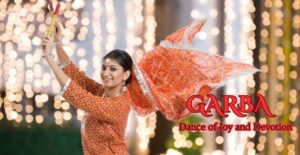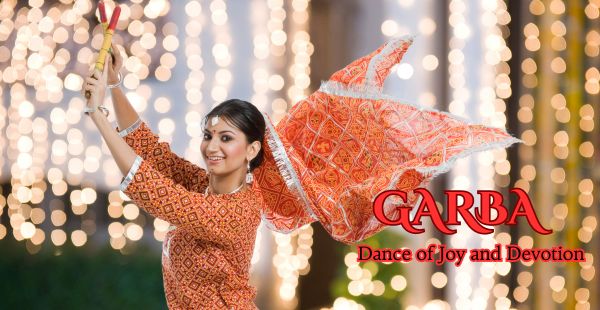
What is Garba and Dandiya? Garba and Dandiya are vibrant, lively dance forms that are an integral part of the cultural fabric of India, particularly in the state of Gujarat. These traditional dances are not just forms of entertainment; they carry deep cultural significance and are an expression of devotion, community, and celebration. In this blog post, we will delve into the origins and historical roots of Garba, exploring why these dances hold such an important place in Indian culture.
The Origins of Garba and Dandiya
Historical Roots
Garba has its roots in the ancient rituals performed to honor the goddess Durga during the Navaratri festival, which spans nine nights of worship and celebration. The word “Garba” is derived from the Sanskrit term “Garbh,” meaning womb, symbolizing fertility and the divine feminine. Traditionally, Garba is performed around a clay pot, known as a ‘garbha,’ which holds a lamp or diya, representing the divine light.
Dandiya, on the other hand, traces its origins to the folk dances of Gujarat and the ancient martial arts practiced by warriors. The term “Dandiya” refers to the sticks used in the dance, which symbolize the swords of the warriors. Over time, Dandiya evolved into a vibrant dance form performed during celebrations, particularly during Navaratri.
Cultural Significance
Both Garba and Dandiya are deeply intertwined with the themes of devotion, celebration, and community. They not only serve as a means of worship but also foster a sense of togetherness among participants. The rhythmic clapping and movement in Garba and the energetic twirling with sticks in Dandiya create an atmosphere of joy and festivity, highlighting the cultural significance of Garba and Dandiya as vital expressions of collective identity.
The Dance Forms: Garba and Dandiya
Garba Dance
Garba is characterized by circular movements and rhythmic clapping, often performed in a group. The dancers move in a circular formation, embodying the cyclical nature of life, creation, and the universe. The music played during Garba is typically upbeat and energetic, featuring traditional instruments like dhol, tabla, and harmonium.
Attire
The attire and costumes for Garba and Dandiya are vibrant and colorful. Women typically wear traditional chaniya choli, consisting of a long skirt (chaniya) and a blouse (choli), often embellished with mirrors and embroidery. Men often wear kurta and dhoti or colorful kurtas paired with traditional headgear. This colorful attire adds to the festive atmosphere and reflects the joyous spirit of the occasion.
Dandiya Dance
Dandiya is a more structured dance, where participants use colorful sticks to perform coordinated movements. The dance is performed in pairs or groups, where dancers hit their sticks together in a rhythm that complements the music. Dandiya is often associated with the celebration of Raas, which involves intricate footwork and elaborate formations.
The Role of Music in Garba and Dandiya
The music played during Garba and Dandiya is integral to the experience. Traditional songs often narrate tales of mythology, love, and devotion, resonating deeply with the cultural context of the dances. Instruments such as dhol, nagada, and shehnai play a crucial role in creating the lively beats that keep dancers moving, underscoring the role of music in Garba and Dandiya celebrations.
Modern Adaptations
In recent years, contemporary music has found its way into Garba and Dandiya celebrations. Artists blend traditional folk tunes with modern beats, creating a fusion that appeals to younger generations. While this evolution maintains the essence of the dances, it also reflects the changing landscape of Indian music and culture.
The Significance of Navaratri
A Celebration of the Divine Feminine
Navaratri, the nine-night festival during which Garba and Dandiya are most prominently performed, is a time to celebrate the divine feminine energy. Each night is dedicated to a different form of the goddess Durga, representing various aspects of womanhood, strength, and resilience. The dances serve as an expression of devotion and gratitude towards the goddess.
Community and Togetherness
Garba and Dandiya provide a unique opportunity for communities to come together, transcending barriers of age, gender, and social status. During Navaratri, public events and gatherings see people from all walks of life participating, dancing, and celebrating together. This sense of community and togetherness during the Navaratri festival fosters a spirit of unity and inclusiveness.
Modern-Day Celebrations
Garba and Dandiya Events
In urban areas, Garba and Dandiya events have become major attractions during the Navaratri festival. Large-scale gatherings are organized in community centers, parks, and auditoriums, where people come together to dance, celebrate, and connect. These events often feature professional performers and elaborate decorations, making them a grand spectacle.
Global Influence
The popularity of Garba and Dandiya has spread beyond India, with events being organized in various countries around the world. Indian diaspora communities celebrate Navaratri with traditional dances, allowing them to reconnect with their roots while sharing their culture with others. This global influence has led to a fusion of styles, enriching the traditional dances with new interpretations.
Conclusion: The Timelessness of Garba and Dandiya
Garba and Dandiya are more than just dance forms; they are a celebration of life, community, and devotion. Rooted in rich cultural traditions, these dances have evolved over time while retaining their essence. Whether performed in the streets of Gujarat or at a celebration in a foreign land, Garba and Dandiya continue to bring people together, fostering a sense of unity and joy.
As we embrace modern interpretations and adaptations, the spirit of Garba and Dandiya remains timeless. They remind us of the importance of community, the celebration of culture, and the power of dance to express emotions that words sometimes cannot convey. So, as you participate in Garba and Dandiya celebrations, remember the meaning behind the movements, the stories behind the songs, and the sense of belonging that these dances cultivate.

